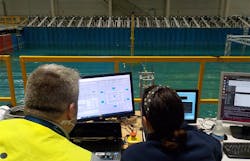LR grants approval for floating wind ballast management technique
Offshore staff
LONDON – Lloyd’s Register (LR) has issued Seaplace approval in principle for an active ballast control system for the company’s CROWN floating offshore wind development.
The technology, which includes buoy and reduced-draft spar operational concepts, is claimed to cut capex costs of floating wind power generation.
The control system is deployed to ballast/de-ballast the platform, changing the floater from its transport draft to its operational draft, and vice versa.
It can also be used to partially or fully compensate the tilt produced by the wind loads in order to improve the stability of floating offshore wind platforms. In addition, its software allows for remote manual operation, semi-automatic control and automatic operation.
The system can stabilize the platform if a compartment incurs damage. In addition, the in-built redundancy is said to ensure the system keeps functioning even if one component, such as a valve or pump, happens to fail.
LR reviewed the system against applicable Rules and Regulations for the Classification of Offshore Units, including the acceptance of preliminary Failure Modes Effects and Criticality Analysis (FMECA).
Seaplace’s system, designed to work with different types of floating wind platforms, was first tested with software-in-the-loop tests and then with scale model tests performed at the IH Cantabria Offshore basin, as part of the CROWN project.
Approval in principle forms part of the final phase of the development, allowing Seaplace to move forward with the full-size demonstration concept.
Mark Darley, LR Marine & Offshore Director, said: “This novel technology could help operators and their floating wind assets reach their market potential, with estimates of up to 10 GW of capacity projected to be installed globally by 2030 and more than 100 GW by 2050.”
According to Seaplace, the floater concept could host not only large wind turbines, but also hydrogen/ammonia systems and solar panels, without impacting the unit’s stability.
05/17/2021
